Some say it feels like walking through a field of gravestones. Others liken it to a maze of coffins, disorientating and eerily quiet despite being in the middle of Berlin.
The German capital’s somber Holocaust memorial — an arrangement of 2,711 concrete steles that has drawn millions of visitors — marks its 20th anniversary this month. The Memorial to the Murdered Jews of Europe has become a powerful symbol of Germany’s determination to ensure the crimes of the Holocaust are not forgotten.
But as the world readies to mark the 80th anniversary of the end of World War II, fears are growing that the nation’s strong tradition of remembrance is starting to erode.
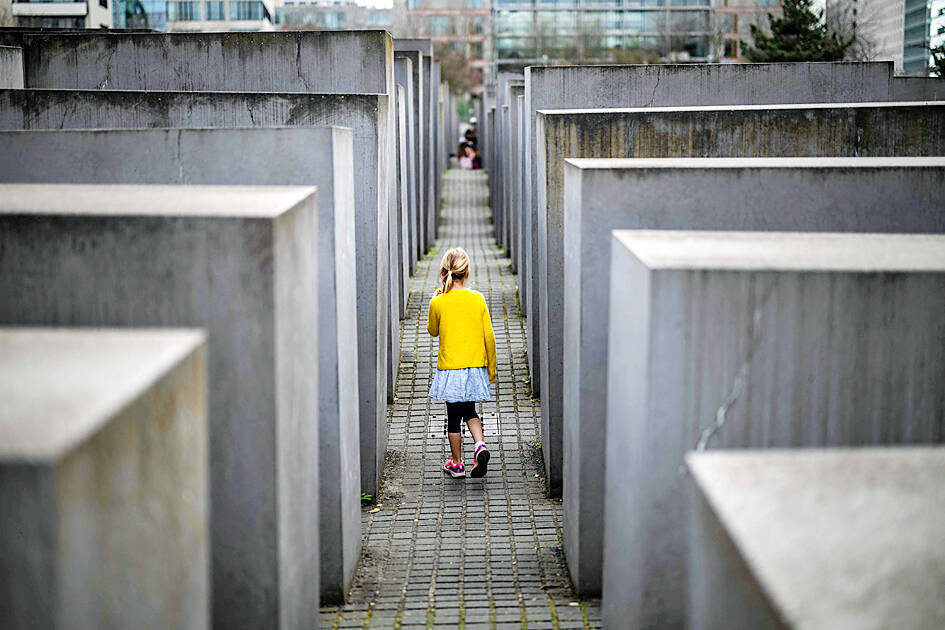
Photo: AFP
Architect Peter Eisenman, whose New York firm designed the memorial, said he wanted to create “an experience that you would have walking in the space like you couldn’t have in any other space in the city.”
“People find it quite scary, because even though it’s open to the city, you can disappear and you can lose a child, for example,” said Eisenman, 92.
However, the idea “was not to make people feel bad or guilty or anything like that,” he said.
“Kids love it because they play tag and hide-and-seek and run around, and people sunbathe on the pillars. You’re supposed to do whatever you want to do. It’s not prescribed,” he said.
The idea of establishing a central Holocaust memorial in Berlin was born in the 1980s, but the project was delayed for several years amid concerns that it might provoke anti-Semitism.
The German parliament finally agreed on the project in 1999 and the finished memorial, including an underground information center, officially opened on May 10, 2005.
There are no figures on how many people visit it each year, but Uwe Neumaerker, the head of the foundation that takes care of it, said that in general “everyone who visits Berlin also visits this memorial.”
“It is accessible day and night, and there are always visitors here. It’s hard to say that people love it, but they have taken it into their hearts,” he said.
Maintaining and securing the memorial costs about 2 million euros (US$2.3 million) a year, but “considering the crowds of visitors, it’s money well spent,” he said.
On any given day in Berlin, in any weather, groups of tourists can be seen wandering through the steles, taking pictures and pausing to reflect on history.
“I think the German nation have been good to put something like that as a memorial,” said Clifford Greenhalgh, 74, visiting from England on a sunny spring day. “You can have a statue, but I think something like that, it’s unforgettable. There are no names, but you don’t need any names.”
Polina Chernyavskaya, a 24-year-old student from Kazakhstan, said: “While I am walking here I feel pretty calm and peaceful. It’s like when you come to a cemetery. It’s very quiet and you can think.”
Remembrance of the Nazis’ atrocities and the theme “never again” have for decades been a central feature of German politics and society as the country seeks to atone for its dark past. However, concerns are growing amid a rise in support for the far-right Alternative for Germany (AfD), which emerged as the second-biggest party in the federal elections in February.
The party’s Bjoern Hoecke has called the Berlin remembrance site a “memorial of shame.”
US tech billionaire Elon Musk made a video appearance at an AfD rally where he said Germany was focused “too much on the guilt of the past.”
In a study published by EVZ, a foundation dedicated to remembrance culture, more than 38 percent of respondents agreed that it was time to “draw a line” under the Nazi era.
Veronika Hager, a consultant to the EVZ board of directors, said the result could be seen as a “tipping point” for remembrance culture. Despite the initial concerns, the Holocaust memorial has been largely spared from a reported rise in anti-Semitic attacks and vandalism in Germany in recent years.
However, a Spanish tourist was seriously injured in February in a stabbing attack there. Police arrested a Syrian man who they said was a sympathizer of the Islamic state group.
“We live in difficult times where right-wing extremists and neo-Nazis are becoming increasingly vocal,” Neumaerker said. “I believe that in these times, a memorial like this is more important than ever.”
Asked whether the memorial will still be relevant in another 20 years’ time, Eisenman was optimistic.
“I think we did a good memorial. It’s abstract. It doesn’t tell you what to do. It doesn’t confine you. It’s not kitsch. It’s very serious... I think it’ll be there a long time,” he said.
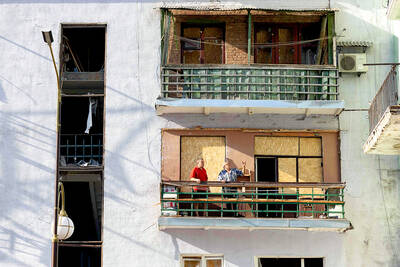
DEADLOCK: Putin has vowed to continue fighting unless Ukraine cedes more land, while talks have been paused with no immediate results expected, the Kremlin said Russia on Friday said that peace talks with Kyiv were on “pause” as Ukrainian President Volodymyr Zelenskiy warned that Russian President Vladimir Putin still wanted to capture the whole of Ukraine. Meanwhile, US President Donald Trump said that he was running out of patience with Putin, and the NATO alliance said it would bolster its eastern front after Russian drones were shot down in Polish airspace this week. The latest blow to faltering diplomacy came as Russia’s army staged major military drills with its key ally Belarus. Despite Trump forcing the warring sides to hold direct talks and hosting Putin in Alaska, there
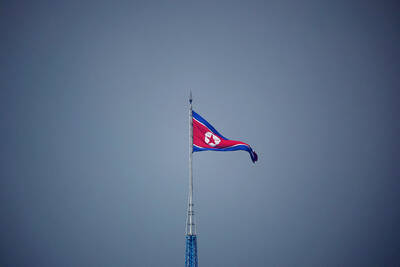
North Korea has executed people for watching or distributing foreign television shows, including popular South Korean dramas, as part of an intensifying crackdown on personal freedoms, a UN human rights report said on Friday. Surveillance has grown more pervasive since 2014 with the help of new technologies, while punishments have become harsher — including the introduction of the death penalty for offences such as sharing foreign TV dramas, the report said. The curbs make North Korea the most restrictive country in the world, said the 14-page UN report, which was based on interviews with more than 300 witnesses and victims who had
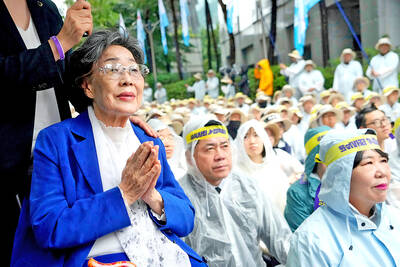
COMFORT WOMEN CLASH: Japan has strongly rejected South Korean court rulings ordering the government to provide reparations to Korean victims of sexual slavery The Japanese government yesterday defended its stance on wartime sexual slavery and described South Korean court rulings ordering Japanese compensation as violations of international law, after UN investigators criticized Tokyo for failing to ensure truth-finding and reparations for the victims. In its own response to UN human rights rapporteurs, South Korea called on Japan to “squarely face up to our painful history” and cited how Tokyo’s refusal to comply with court orders have denied the victims payment. The statements underscored how the two Asian US allies still hold key differences on the issue, even as they pause their on-and-off disputes over historical
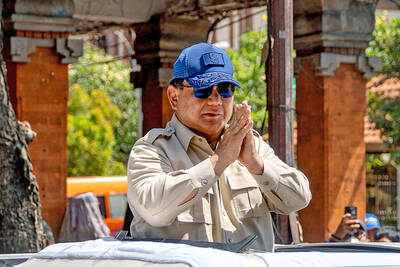
CONSOLIDATION: The Indonesian president has used the moment to replace figures from former president Jokowi’s tenure with loyal allies In removing Indonesia’s finance minister and U-turning on protester demands, the leader of Southeast Asia’s biggest economy is scrambling to restore public trust while seizing a chance to install loyalists after deadly riots last month, experts say. Demonstrations that were sparked by low wages, unemployment and anger over lawmakers’ lavish perks grew after footage spread of a paramilitary police vehicle running over a delivery motorcycle driver. The ensuing riots, which rights groups say left at least 10 dead and hundreds detained, were the biggest of Indonesian President Prabowo Subianto’s term, and the ex-general is now calling on the public to restore their